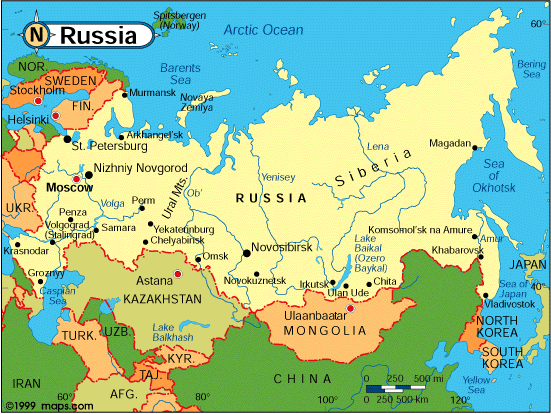Russia is the world's largest country by land area, Russia ranks sixth in terms of population. It The country Russia is bounded by Norway and Finland in the northwest; by Estonia, Latvia, Belarus, and Ukraine in the west; by Georgia and Azerbaijan in the southwest; and by Kazakhstan, Mongolia, and China along the southern land border. The Kaliningrad Region is an exclave on the Baltic Sea bordered by Lithuania and Poland. Moscow is the capital and largest city.
It occupies much of E Europe and all of N Asia, extending for c.5,000 mi (8,000 km) from the Baltic Sea in the west to the Pacific Ocean in the east and for 1,500 to 2,500 mi (2,400–4,000 km) from the Arctic Ocean in the north to the Black Sea, the Caucasus, the Altai and Sayan mts., and the Amur and Ussuri rivers in the south. The Urals form the conventional geographic boundary between the European and Siberian parts of Russia. Russia's dominant relief features are (from west to east) the East European plain, the Urals, the West Siberian lowland, and the central Siberian plateau.
Mt. Elbrus (18,481 ft/5,633 m), in the Caucasus, is the highest peak in the country. The chief rivers draining the European Russia are the Don (into the Black Sea), the Volga (into the Caspian Sea), the Northern Dvina (into the White Sea), the Western Dvina (into the Baltic Sea), and the Pechora (into the Barents Sea). (For the main physical features of the Siberian Russia, see Siberia.) The climate of Russia, generally continental, varies from extreme cold in N Russia and Siberia (where Verkhoyansk, the coldest settled place on earth, is situated), to subtropical along the Black Sea shore. The soil and vegetation zones include the tundra and taiga belts, the entire wooded steppe and northern black-earth steppes, and isolated sections of semidesert, desert, and subtropical zones.
